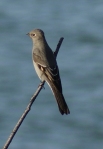On the wild side—February, 2011
by Tina Mitchell
Walk out early on a winter’s morning anywhere near juniper trees and you’re likely to hear a single, repeated, resonant “peep” slice through the cold morning air. This winter whistler? A Townsend’s Solitaire. Slim and long-tailed, these solitaires frequent pinyon/juniper habitats in our area from September through March. At first glance, you see an unassuming gray bird—not very noteworthy. But a close look reveals a subtle beauty, with the gray set off by a striking white eye-ring, soft buff-colored patches on the wings, and white on the outer tail feathers. Members of the thrush family (which includes American Robin, the 3 species of bluebirds, and the spotted thrushes such as the Hermit Thrush), Townsend’s Solitaires nest in mountainous regions of western North America from Alaska to New Mexico. They typically don’t migrate far, merely dropping a bit in altitude between summer and winter grounds.
a single, repeated, resonant “peep” slice through the cold morning air. This winter whistler? A Townsend’s Solitaire. Slim and long-tailed, these solitaires frequent pinyon/juniper habitats in our area from September through March. At first glance, you see an unassuming gray bird—not very noteworthy. But a close look reveals a subtle beauty, with the gray set off by a striking white eye-ring, soft buff-colored patches on the wings, and white on the outer tail feathers. Members of the thrush family (which includes American Robin, the 3 species of bluebirds, and the spotted thrushes such as the Hermit Thrush), Townsend’s Solitaires nest in mountainous regions of western North America from Alaska to New Mexico. They typically don’t migrate far, merely dropping a bit in altitude between summer and winter grounds.
Although they eat predominantly insects during the summer, their diet becomes extremely specialized in winter, when they feed almost exclusively on juniper berries. (Factoid—juniper “berries” are really small, fleshy cones.) Research has shown that solitaires possessing large, berry-rich territories survive the winter at higher rates than do those on small territories with fewer berries. Because of the importance of this food source, solitaires display a characteristic unlike most other avian species: They vigorously defend winter territories through vocalizations (e.g., that loud, piercing whistle) and vigilant scanning for and chasing of intruders—often while perching on high, exposed branches. Also unlike most other bird species, they sing their beautiful complex song of clear musical warblings throughout the winter. Deep in the bleak mid-winter, your spirits may lift just a bit when this gorgeous sound rings through the chilly air.
Its scientific name—Myadestes townsendi—derives from the Greek words for fly (muia) and eater (edestes). (Clearly, the species was named based on its summer diet rather than its winter diet.) Both the species name and the common name pay tribute to John Kirk Townsend, an ornithologist from Philadelphia who traveled and collected birds in the western U.S. “Solitaire” reflects the fact that, except during breeding season, they are generally found alone. The Townsend’s Solitaire is the only member of the Myadestes genus that lives in the continental U.S. However, Hawai’i hosts 5 species on its various islands: Oma’o, Kama’o, Oloma’o, ‘Amaui, and Puaiohi. (Sometimes I think the Hawaiian language must have gotten a great deal on vowel sounds when it was forming.)
The Townsend’s Solitaire’s complex, lilting, song. An often hard-to-locate call note. Its ethereal gray presence. All work together to give the solitaire, as the late Rich Levad wrote in the Colorado Breeding Bird Atlas, a blend of mystery and melancholy beloved by romantic poets. Had John Keats lived in Colorado, we could easily have had an “Ode to a Solitaire.”
You can learn more about this understated beauty and hear clips of its voice here.
(Photo credit: SriMesh, from WikiMedia Commons)
